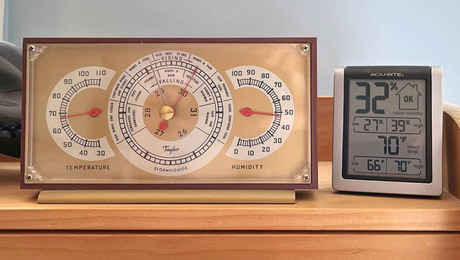Beam and Joist repair in balloon framed home
I have a sagging beam and joists in an old balloon framed house that I would like to remedy before I start any finish work. The beam is a 2 ply rough 2x7ish spanning 16′ and supported by 3 posts (8′ max span). The rough 2×6 joists are notched over the beam and over the sill at the other end of their 12′ span. This is all basement ceiling framing. Both are sagging due to age and lack of size.
I was thinking of replacing the beam with an appropriately sized LVL(s) and either sistering or building a wall under the middle of the current joists. The 2″ concrete slab in that area is weak and already cracked in places.
I want some opinions on this repair. Is cutting out and replacing the beam the best way or is reinforcing it a better idea? What about the joists. How would either of these be accomplished safely and effectively?
See the attached diagram.
Thanks


















Replies
A little more info would be helpful here I think. What are the 2 openings under the beam for, large doors out from the basement? Depending on what you need for floor space or headroom in the basement will determine what the best structural solution will be. The simplest would be to leave everything as is and build 3 walls - one under each end of the floor joists and one in the middle of the span. If you plan to use your basement more efficiently then there are other ways to engineer this. Let me know what you are trying to do down there and I will happily throw my 2 cents in. Thanks.
Engineer needed
Howdy, how many stores is the building? Is this the center girder? How much $ do you have to spend... A structural enginer can advise you what to do to support it and size the supports. It may be to simply sister LVLs an botlt them to the existing girder. But determining the loading of the posts and footers needed for them may require much more. The fee would be money well spent for a report.
I just did a repair to a grand home girder. It had a 2" slab so i installed a 8" reinsforced 24" spread footer and then installed 2 by 8 "T" stud wall 12" on center moving 8' from post to post and allwoing the footer to cure before continuing the next 8'... I found when removing the old posts that the builder in 1903 did not place them on anything other the the sandy soil. The concrete floor had been poured around the posts. Over the 100+ years these 6 by 6 by 8"posts setteled about 2" into the soil. Hand mixing the cement in the basement in my wheel barrow was a lot of work. But since the girder was way under sized and the posts were sunkeni am glad i did not just beef ip the girder. The heads up about under sized girder for todays loads in a home and the fact that the posts may not have any or in adequate footers is why i shared my repair.
This information worked for me but i am no way or means suggesting it is in anyway correct or proper nor implying it would work for anyone else. Do do not rely on it at all. Without proper shoring and Construction background do not try this. People get hurt. Hire an enginer and a contracrtor if you do not know enough because having a collapse or doing $1,000s an !,0000 of damage by not knowing enough is a real possibility. Be smart careful.
Balloon Frame repair
If this is a true balloon frame house, then you should see the bottoms of the the 1st fl. studs( which are also the 2nd fl. studs)
sitting on top of the beam.To provide proper support for the second fl. and for the replacement of the main beam, you must also
build a wall on the 1st fl. directly over the temp. wall in the basement, one on each side of the main beam, supporting the 1st
floor ceiling. Balloon frame means that the center wall carries the second floor load directly down onto the top of the main beam
in the basement, and you need to temporarily support that load while you replace/repair the main beam.
hope this is of some help,
Geoff
Howdy i replied to you post days ago but it was not presented. First great time to have a structual enginer consult for the proper design for loading the beam a verbal report while at the site is the least expensive. This girder beam is set on posts that may not have any spread footer under the post an over time the posts probably have setteled. ( i just found and fixed this issue in my grand old home) an enginer can advise what if any additional framing members must be added to the girder and the sizes and how to attach them. To install spread footers and jack up the girder temporty shoring plus basement jacks works. ARE you sure you have enough construction knowledge for this ? Might be a great time to hire and help a contractor that has the background for this type of repair .
Are you seeing wall cracking and doors not closing correctly above this beam- that is common with setteling .
The issue was just the actual method of fixing the beam. A friend of mine had suggested reinforcing it with an LVL underneath but I didn't think that was the best solution. I am going to build a temp wall under the floor joists and support the wall above. Then I will remove the old rough cut 2x6 beam and replace it with a couple 1.75x9.5 LVLs. The old joists will be hung with new joist hangers from the LVL. I will probably add a beam in the middle of the joist span to help the sag there. New 18x18x12" concrete footings will support the PT 4x6 posts.
The house is old and the plaster is in though shape and cracked anyway. I have a bunch of drywall in the garage to replace all of it. I have been going through the house leveling things out, replacing beams and joists, jacking up and reframing walls etc. I'm a mechanical engineer so I'm pretty familiar with all the structural stuff. It's not that bad if you follow the IRC, the NDS and ASCE 7. LVL mfgs have span tables in their literature as well. My concrete footings could probably be a little bigger, maybe 24"x24" but other than that I think I'm ok. Maybe there is something I'm missing that a structural engineer could tell me but I don't think I need to hire somebody for this.
Thanks
Sounds great
Howdy, I did not mean to imply that you personally lacked the background to do the repairs. After doing similar repairs reciently myself just wanted to add a few words of caution. Might add a 3rd LVL so the flooring above has less deflection.But then again that would depend on how much loading is on that girder. But I am courous with your knowledge why so few details initally presented?
The problem is that I am an engineer so I obsess over simple details and sometimes don't know when to say "good enough". I don't know a lot of contractors or builders, most of what I know comes from books so I like to get input from people that actually do this stuff everyday so I have a better idea of when I'm overdoing it. I just wanted to ask to see what most guys would do in this scenario and if it included a full fledged tear out and replace.
The beam only supports two 12' span floors (so 6' tributary) and one interior wall. There is a beam on either side of the stairs so it only supports a floor to one side. Basically it doesn't support a whole lot speaking relatively. Per calculation a single LVL would do the trick and meet strength and deflection numbers for the loads, however the bearing area (compression perpendicular to the grain) is a little high. Adding a second ply doubles the bearing area at each post and just makes everything stronger. With two LVLs I think the theoretical deflection was better than l/720, might have even been better than l/999.